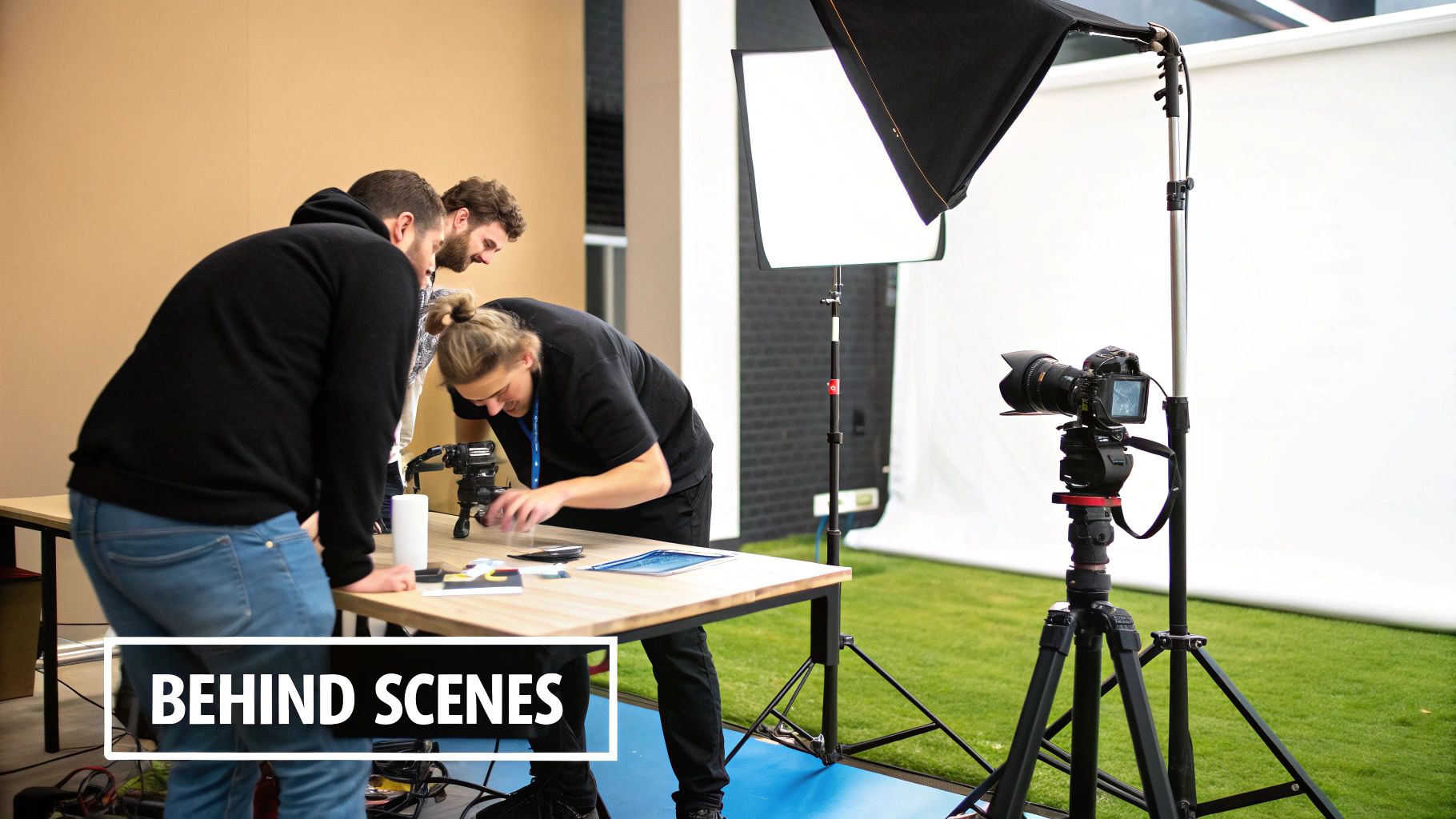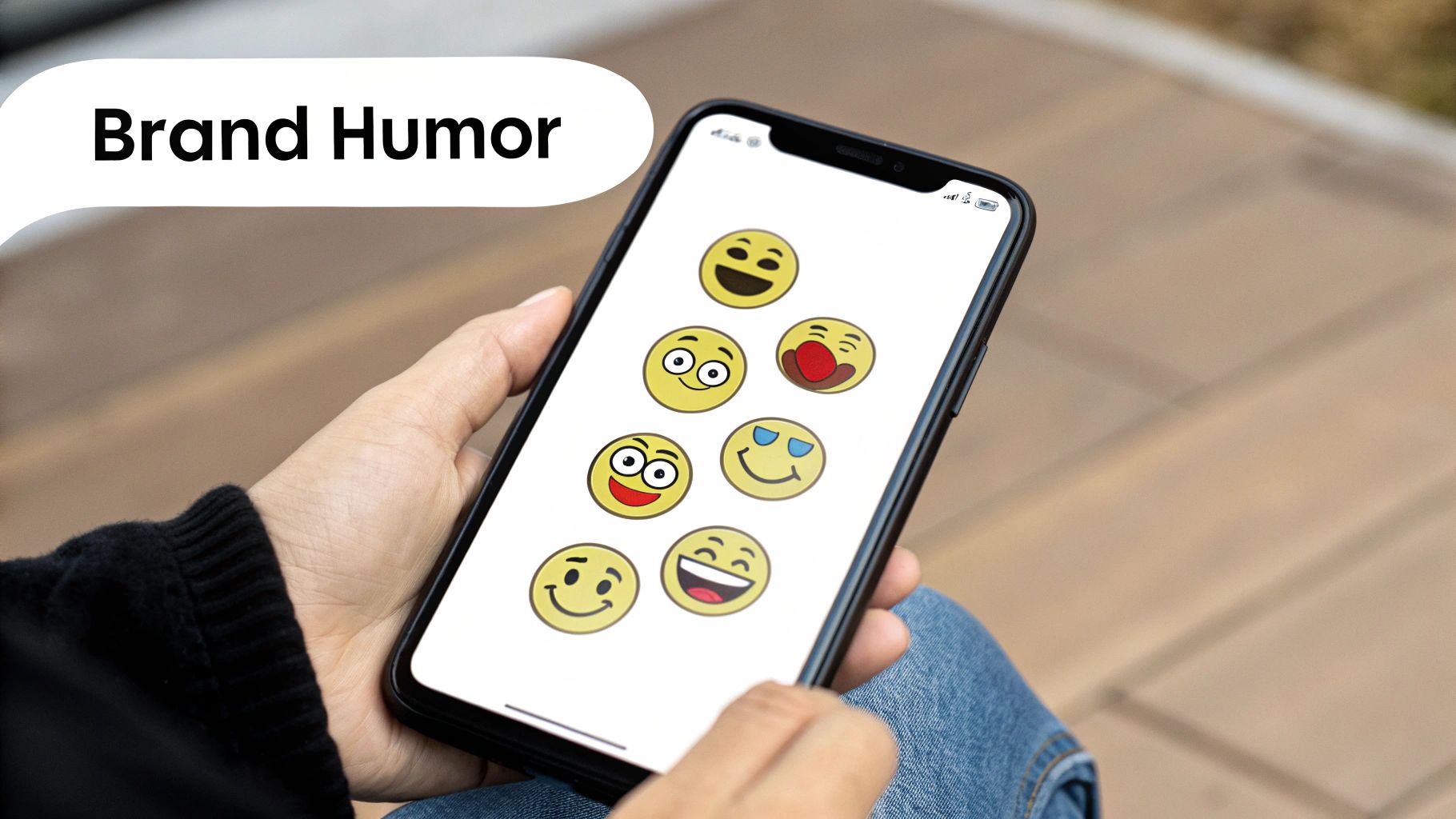
9 Fresh Social Media Content Ideas for Professionals in 2025
Published on 2025-07-18
In a digital world saturated with noise, creating content that stops the scroll and starts a conversation is more critical than ever. Standard posts no longer cut it, especially for professionals aiming to build authority and foster genuine connections on platforms like LinkedIn. The challenge isn't just to be present, but to be impactful. This guide moves beyond generic advice to provide you with a curated list of powerful and proven social media content ideas.
Each idea is designed to humanize your brand, showcase your expertise, and spark meaningful engagement. Whether you are building a personal brand or managing a corporate presence, these strategies offer a fresh perspective for your content calendar. For even more inspiration, explore these 10 actionable social media content ideas that can help you stand out and boost engagement.
We will break down nine specific concepts, from user-generated content and behind-the-scenes glimpses to interactive polls and professional tutorials. You'll learn not only what to post but how to adapt each idea for a discerning professional audience. Get ready to explore fresh, high-engagement concepts that deliver real results, transforming your social media from a monologue into a dynamic dialogue.
1. User-Generated Content (UGC) Campaigns
User-Generated Content (UGC) campaigns are a powerful strategy where you encourage your audience to create and share content that features your brand, products, or services. This approach transforms loyal customers into authentic brand ambassadors, building a library of trustworthy content that resonates far more effectively than traditional advertising. It is one of the most impactful social media content ideas because it leverages genuine customer experiences as social proof.

This method thrives on authenticity. When potential customers see real people enjoying your offerings, it builds immediate trust and credibility. Think of GoPro, which built its entire marketing foundation on showcasing incredible, high-adrenaline videos captured by its users. Similarly, Airbnb's travel campaigns often feature photos and stories from guests, painting a vivid picture of the unique stays available worldwide.
How to Implement a UGC Campaign
- Launch a Branded Hashtag: Create a simple, memorable hashtag that is unique to your campaign. This makes it easy to track submissions and build a cohesive collection of content. For example, a B2B software company could use #[YourSoftware]InAction.
- Offer Clear Incentives: Motivate your audience to participate. Offer prizes for the best submissions, feature top posts on your official channels, or provide exclusive discounts to everyone who contributes.
- Set Clear Guidelines: Define what you’re looking for. Specify the theme, tone, and any mandatory elements, like tagging your brand or using the specific hashtag, to ensure submissions align with your brand identity.
- Engage and Amplify: Actively like, comment on, and share user submissions. This not only encourages more participation but also shows your community that you value their contributions. Regularly featuring user content makes your audience feel seen and appreciated.
2. Behind-the-Scenes Content
Behind-the-scenes content gives your audience an exclusive look into your company's daily operations, production processes, and team culture. This strategy humanizes your brand by showcasing the real people and work behind your products or services, fostering a deeper connection with your followers. It is a fantastic addition to your list of social media content ideas because it builds trust through transparency and authenticity.

Pulling back the curtain makes your brand more relatable and interesting. For example, Warby Parker frequently shares glimpses of its design studio and company culture, connecting with customers on a personal level. Similarly, brands like Ben & Jerry's have captivated audiences for years by showing their ice cream making process, turning a factory floor into a source of entertainment and brand loyalty. This approach demonstrates your company's values and dedication in action.
How to Implement Behind-the-Scenes Content
- Spotlight Your People: Introduce the team members who make your business run. Share a short video of an engineer explaining a product feature or a photo of your customer support team at work. This puts a human face to your brand name.
- Showcase Your Process: Document how your product is made or how your service is delivered. This could be a time-lapse of a product being assembled, a walkthrough of your office, or a look at a brainstorming session for a new marketing campaign.
- Balance Authenticity and Professionalism: While the goal is to be genuine, ensure your content still aligns with your brand's professional image. Keep the workspace tidy and the context appropriate, even when sharing candid moments.
- Use Stories for Casual Updates: Leverage Instagram Stories, Facebook Stories, or LinkedIn Stories for more informal, temporary glimpses into daily life at your company. This format is perfect for quick office tours, "day in the life" takeovers, or unboxing new equipment.
3. Interactive Polls and Q&A Sessions
Interactive polls and Q&A sessions are a fantastic way to engage your audience in real-time conversations while gathering valuable feedback and insights. These formats turn passive followers into active participants, creating a two-way dialogue that builds a stronger sense of community. This is one of the most effective social media content ideas because it provides you with direct data from your audience, helping to guide future content and business decisions.

This method thrives on direct engagement and makes your audience feel heard. For example, a LinkedIn poll can ask professionals about their biggest industry challenges, while an Instagram Q&A can allow a company founder to answer questions directly from customers. Brands like HubSpot frequently use polls to gauge marketing trends, and thought leaders like Neil Patel leverage Q&A sessions to establish authority and connect personally with their followers. For more information, explore these audience engagement strategies on autoghostwriter.com.
How to Implement Polls and Q&A Sessions
- Ask Specific, Engaging Questions: Avoid broad or generic questions. Instead of "What do you want to see?", ask "Which of these topics should our next webinar cover: A) AI in Marketing or B) SEO for B2B?". This makes it easier for people to respond.
- Schedule for Peak Activity: Post your polls and host your Q&A sessions when your audience is most active online. Check your platform analytics to identify these peak times to maximize participation.
- Close the Loop: Always follow up. Share the poll results in a subsequent post or create content based on the winning topic. This shows your audience that their input matters and has a real impact.
- Validate Ideas and Gather Feedback: Use polls as a low-risk way to test new product ideas, content formats, or marketing messages. It’s an easy method for market research that engages your community in the process.
4. Educational and Tutorial Content
Educational content positions your brand as a thought leader by providing genuine value that solves your audience's problems. This approach includes tutorials, how-to guides, industry insights, and step-by-step series that teach your followers a new skill or deepen their understanding of a topic related to your expertise. This is one of the most sustainable social media content ideas because it builds trust and establishes your brand as the go-to resource in its niche.
This method focuses on giving before asking. When you consistently offer valuable knowledge, your audience begins to see you as an authority. Think of HubSpot, which provides comprehensive marketing guides and tutorials that empower professionals, or Canva, whose design tutorials make graphic design accessible to everyone. This strategy attracts a highly relevant audience actively seeking solutions you can provide.
How to Implement Educational Content
- Address Common Pain Points: Identify the most frequent questions and challenges your target audience faces. Create content that directly answers these questions, offering clear, actionable solutions.
- Break Down Complex Topics: Make sophisticated concepts easy to understand. Use formats like carousels, short videos, or step-by-step guides to present information in digestible pieces. For a more in-depth look at this format, you can find a guide to creating engaging educational carousels.
- Use Strong Visuals: Enhance comprehension with visuals like charts, infographics, screen recordings, and animations. Visuals make learning more engaging and help reinforce key takeaways.
- Create Content Series: Develop a multi-part series around a core topic. This builds anticipation and encourages your audience to follow you for the next installment, turning casual viewers into loyal subscribers.
5. Seasonal and Trending Content
Seasonal and trending content leverages current events, holidays, and viral conversations to create timely posts that capture audience attention. This strategy keeps your brand relevant and integrated into the broader cultural dialogue, showing that you are current and engaged. Capitalizing on what people are already talking about is one of the most effective social media content ideas for boosting immediate reach and engagement.
This approach connects your brand to shared experiences, making it more relatable. A classic example is Oreo's 'Dunk in the Dark' tweet during the 2013 Super Bowl blackout, which went viral for its speed and cleverness. Similarly, brands like Wendy's masterfully participate in meme culture, while Spotify’s annual 'Wrapped' campaign brilliantly combines seasonal reflection with personalization, generating massive user-driven buzz. These instances show how timing and relevance can create iconic marketing moments.
How to Implement Seasonal and Trending Content
- Create a Content Calendar: Plan for predictable events like holidays, seasons, and major industry conferences well in advance. This allows you to prepare high-quality, themed content without rushing.
- Monitor Trends Actively: Use tools like X (formerly Twitter) Trending Topics, Google Trends, and TikTok’s 'For You' page to stay on top of what’s currently popular. Speed is critical, so be ready to act fast.
- Ensure Brand Alignment: Before jumping on a trend, ask if it aligns with your brand's voice, values, and audience. A mismatch can feel forced and damage your credibility. For example, a serious financial firm might avoid a silly meme.
- Establish a Fast-Track Approval Process: Time-sensitive content can’t wait for a lengthy review process. Create a streamlined approval system with key decision-makers to enable quick, opportunistic posting.
6. Customer Success Stories and Case Studies
Customer success stories and case studies are narrative-driven content pieces that showcase the real-world results your clients have achieved with your products or services. By focusing on tangible transformations, you provide powerful social proof that demonstrates concrete value. This is one of the most persuasive social media content ideas because it moves beyond marketing claims to highlight proven outcomes, building immense trust with prospects.
This strategy works by framing your offering as the solution to a relatable problem. Think of how Salesforce masterfully shares customer transformation stories, or how Slack details specific team productivity improvements. These examples aren't just testimonials; they are detailed accounts of a journey from a challenge to a resolution, making the benefit of the service crystal clear. They allow potential customers to see themselves in the success of others, making your solution feel both credible and attainable.
How to Implement Customer Success Stories
- Structure the Narrative: Frame your story using a classic problem-solution-result format. Clearly articulate the customer's initial challenge, explain how your product or service was implemented to address it, and finish with the specific, positive outcomes they achieved.
- Focus on Quantifiable Metrics: Use hard data to make your stories more compelling. Include specific numbers, percentages, and quantifiable results, such as "reduced onboarding time by 40%" or "increased lead generation by 150%." These metrics provide undeniable proof of your value.
- Use Compelling Visuals: Enhance your stories with high-quality photos, videos, or graphics. A professional headshot of the client, a short video testimonial, or before-and-after infographics can make the content far more engaging and shareable on social media.
- Get Proper Permissions: Always obtain explicit consent and legal clearance from your customers before featuring their story, name, and company details. This protects both parties and ensures the collaboration is positive. Learn more about creating compelling narratives in our guide to Customer Success Stories and Case Studies.
7. Live Video Content and Streaming
Live video content offers an unparalleled opportunity to connect with your audience in real-time, fostering a sense of immediacy and authenticity that pre-recorded content often lacks. This format includes everything from live Q&A sessions and tutorials to behind-the-scenes glimpses and major product launches. It is one of the most engaging social media content ideas because it creates a direct, unscripted channel for interaction and community building.
This method thrives on its raw and interactive nature. When your audience can ask questions and see your immediate reactions, it breaks down the barrier between brand and consumer, building trust and loyalty. Thought leaders like Gary Vaynerchuk and Amy Porterfield have used live streaming extensively on platforms like LinkedIn and Facebook to host discussions and provide immense value, demonstrating expertise and strengthening their community bonds.
How to Implement Live Video Content
- Promote Your Session in Advance: Build anticipation for your live stream. Announce it on your social channels, in your newsletter, and through stories, letting people know the topic, date, and time so they can plan to attend.
- Plan Key Talking Points: While live video is spontaneous, you should have a clear outline. Prepare key topics, questions to ask your audience, and a call-to-action to ensure the stream stays focused and delivers value.
- Test Your Technical Setup: Nothing ruins a live stream faster than technical glitches. Before going live, test your internet connection, microphone, camera, and lighting to ensure a smooth, professional broadcast.
- Engage with Comments in Real-Time: The magic of live video is the interaction. Acknowledge viewers by name, answer their questions as they come in, and respond to comments. This makes your audience feel seen and actively involved in the conversation.
8. Memes and Humorous Content
Memes and humorous content tap into current internet culture to create highly shareable, engaging posts that humanize your brand. This strategy leverages comedy and relatability to build a stronger community through shared laughs and cultural references. It is one of the most effective social media content ideas because it fosters a lighthearted connection and makes your brand more memorable and approachable.
This approach works by showing a more personal, less corporate side of your business. When done correctly, humor can cut through the noise of a crowded social feed and leave a lasting positive impression. For instance, Wendy's has built a massive following with its witty Twitter roasts and meme-savvy responses, while Duolingo's quirky and sometimes unhinged social media personality has turned its mascot into a viral star.
How to Implement Memes and Humorous Content
- Understand Your Audience's Humor: Not all humor lands with every audience. Research what your community finds funny. Pay attention to the memes, jokes, and humorous accounts they already engage with to ensure your content will resonate.
- Stay Current with Trends: Meme culture moves incredibly fast. Use formats that are currently popular, not ones from months or years ago. Acting quickly on a new trend shows that your brand is relevant and in-the-know.
- Ensure Alignment with Brand Values: Your humor should never undermine your brand's core identity. The goal is to humanize, not to seem unprofessional or out of touch. To successfully implement humorous content, explore effective strategies for marketing with memes that align with your brand voice.
- Don't Force It: If humor doesn't feel natural for your brand or industry, it's better to avoid it. Forced jokes can come across as cringey and do more harm than good. Authenticity is key.
9. Product Demonstrations and Reviews
Product demonstrations and reviews showcase your offerings in action, highlighting features, benefits, and real-world applications. This content type moves beyond static product photos to show potential customers exactly how your solution works and the value it provides. It is one of the most effective social media content ideas for translating complex features into tangible benefits, building trust through transparency.
This approach is powerful because it answers the customer's core question: "How will this help me?" Think of Apple's iconic product launch keynotes, where they don’t just list specs but demonstrate how new features integrate seamlessly into daily life. Similarly, brands like Home Depot create short videos showing their tools in action during a real DIY project, making the product’s utility immediately clear and compelling.
How to Implement Product Demonstrations and Reviews
- Focus on Benefits, Not Just Features: Instead of saying your software has "AI-powered analytics," show how it "automatically identifies your top three sales opportunities in under 60 seconds." Connect every feature to a direct user benefit.
- Show, Don't Just Tell: Create content that places your product in a realistic context. For a B2B SaaS tool, this could be a screen recording of a user solving a common workflow problem. For a physical product, show it being used in its intended environment.
- Be Honest and Transparent: Build credibility by addressing potential limitations or best-use cases. Acknowledging who your product is not for can make your claims more believable to your ideal audience.
- Use High-Quality Visuals: Ensure your videos are well-lit, your audio is crisp, and any on-screen text is easy to read. Professional presentation reinforces the quality of your product and brand. Include a clear call-to-action, such as a link to a free trial or a product page.
Comparison of 9 Social Media Content Ideas
| Content Type | Implementation Complexity 🔄 | Resource Requirements ⚡ | Expected Outcomes 📊 | Ideal Use Cases 💡 | Key Advantages ⭐ |
|---|---|---|---|---|---|
| User-Generated Content (UGC) Campaigns | Medium - requires moderation & guidelines | Low - relies on audience content | High engagement, authentic social proof | Brands seeking community engagement & reach | Builds trust, cost-effective, diverse content |
| Behind-the-Scenes Content | Medium - consistent content creation needed | Medium - employee involvement | Builds trust, humanizes brand | Showcasing culture and transparency | Authenticity, emotional connection, ongoing content |
| Interactive Polls and Q&A Sessions | Medium - real-time monitoring required | Low-medium - needs active hosting | Increased engagement, valuable feedback | Real-time audience interaction & insights | Direct feedback, community building |
| Educational and Tutorial Content | High - requires expertise and planning | High - requires content creation | Establishes authority, lasting audience value | Thought leadership, skill building | Credibility, SEO boost, shareable valuable advice |
| Seasonal and Trending Content | Medium - quick response and planning | Low-medium - timely content creation | Increased visibility, relevance | Time-sensitive marketing & cultural moments | High engagement, brand relevance |
| Customer Success Stories and Case Studies | Medium - needs customer cooperation | Medium - data gathering & storytelling | Builds trust, social proof | Demonstrating product ROI and value | Powerful proof, credible, persuasive |
| Live Video Content and Streaming | High - live setup and confidence required | Medium - equipment & scheduling | Real-time engagement and community building | Launches, tutorials, interactive sessions | Authenticity, direct interaction, cost-effective |
| Memes and Humorous Content | Low-Medium - creativity focused | Low - quick content creation | Viral potential, emotional connections | Brand relatability and informal engagement | Highly shareable, humanizes brand |
| Product Demonstrations and Reviews | Medium-High - detailed production & updates | Medium - product access & editing | Drives sales, reduces support questions | Showcasing product features and benefits | Transparency, trust, informed customer decisions |
Putting Your Ideas into Action: Your Next Steps
You've just explored a comprehensive toolkit of powerful social media content ideas, from harnessing the authenticity of User-Generated Content to leveraging the timely appeal of trending topics. The journey from inspiration to impact, however, depends on consistent and strategic execution. The true power lies not in knowing these nine concepts, but in how you adapt, test, and integrate them into your unique content strategy.
Remember, every idea we discussed, whether it's a detailed case study or a lighthearted meme, shares a common goal: to create a genuine connection with your audience. The most successful professional brands on platforms like LinkedIn don't just broadcast; they engage, educate, and build community.
Your Path Forward: From Idea to Implementation
To avoid feeling overwhelmed, don't try to implement everything at once. The key to sustainable growth is a methodical, focused approach. Here’s a simple, actionable plan to get you started today:
- Select Your Starting Point: Choose just two or three ideas from this list that resonate most with your brand and feel easiest to execute. A quick poll and a behind-the-scenes post are often excellent, low-barrier entry points.
- Create a Simple Calendar: Plan out when you will post these new content types over the next two weeks. Consistency is more important than frequency. A well-executed post once a week is better than five rushed ones.
- Analyze and Adapt: Pay close attention to your analytics. Which format generated the most comments? Which one earned the most shares? Use this data to inform your next set of content decisions, doubling down on what works for your specific audience.
The Value of a Vibrant Content Strategy
Mastering these content frameworks is about more than just filling your feed. It’s about building a robust professional brand that attracts opportunities, fosters meaningful network connections, and establishes you as a thought leader in your industry. Each piece of content is a building block for your digital reputation. The more value you provide, the stronger and more influential your presence becomes.
As you continue to build your content library, always look for fresh perspectives to keep your strategy dynamic. For even more inspiration and to see different takes on these core concepts, you can explore additional Top 9 Social Media Content Ideas for 2025 to ensure your approach never gets stale. By combining proven frameworks with ongoing learning, you set yourself up for long-term success. The most engaging content is simply waiting for you to bring it to life.
Ready to turn these social media content ideas into high-quality posts without spending hours writing? autoghostwriter uses advanced AI to help you generate engaging, professional content tailored to your unique voice and expertise. Supercharge your content creation and start building a powerful online presence today with autoghostwriter.